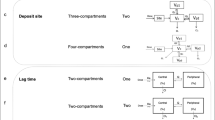Abstract
Purpose. To develop a new pharmacokinetic model for ascorbic acid (vitamin C) since no previously published model describes ascorbic acid absorption and disposition over a broad physiologic range of doses and plasma concentrations.
Methods. A new model was developed through exploratory simulations. The model was fitted to pharmacokinetic data obtained from seven healthy volunteers who underwent ascorbic acid depletion then gradual repletion. Concentrations of ascorbic acid were measured in plasma and urine. Final pharmacokinetic model parameter estimates were obtained using nonlinear regression analysis.
Results. The new model included saturable absorption, distribution and renal tubular reabsorption parameters. The model described ascorbic acid concentrations in plasma, cells, and urine during depletion and gradual repletion phases with a residual error less than 15%.
Conclusions. The model was useful for obtaining a new understanding of the likely causes for the complex concentration-time profile observed during gradual repletion. At doses of 200 to 2500 mg per day, the plateau in pre-dose concentrations is largely due to apparent saturation of tissue uptake and less a function of oral bioavailability and renal excretion than previously thought.
Similar content being viewed by others
REFERENCES
J. Blanchard, K. A. Conrad, R. A. Mead, and P. J. Garry. Am. J. Clin. Nutr. 51:837–845 (1990).
S. Yung, M. Mayersohn, and J. B. Robinson. J. Pharm. Sci. 67:1491–1492 (1978).
G. Zetler, G. Seidel, C. P. Siegers, and H. Iven. Eur. J. Clin. Pharmacol. 10:273–282 (1976).
A. Kallner, D. Hartmann, and D. Hornig. Am. J. Clin. Nutr. 32:530–539 (1979).
S. Melethil, M. B. Subrahmanyam, C. J. Chang, and W. D. Mason. Ann. NY Acad. Sci. 498:491–493 (1987).
V. K. Piotrovskij, Z. Kallay, M. Gajdos, M. Gerykova, and T. Trnovec. Biopharm. Drug. Dispos. 14:429–442 (1993).
M. Mayersohn. Eur. J. Pharmacol. 19:140–142 (1972).
S. Melethil, W. D. Mason, and C. J. Chang. Internat. J. Pharmaceu. 31:83–89 (1986).
P. W. Washko, D. Rotrosen, and M. Levine. J. Biol. Chem. 264:18996–19002 (1989).
P. Bergsten, G. Amitai, J. Kehrl, K. R. Dhariwal, H. G. Klein, and M. Levine. J. Biol. Chem. 265:2584–2587 (1990).
R. W. Welch, P. Bergsten, J. D. Butler, and M. Levine. Biochem. J. 294:505–510 (1993).
P. Bergsten, R. Yu, J. Kehrl, and M. Levine. Arch. Biochem. Biophys. 317:208–214 (1995).
E. P. Ralli, G. J. Friedman, and S. H. Rubin. J. Clin. Invest. 17:765–770 (1938).
M. Levine, C. Conry-Cantilena, Y. Wang, R. W. Welch, P. W. Washko, K. R. Dhariwal, J. B. Park, A. Lazarev, J. F. Graumlich, J. King, and L. R. Cantilena. Proc. Natl. Acad. Sci. USA 93:3704–3709 (1996).
J. King, R. W. Welch, Y. Wang, K. R. Dhariwal, C. Conry-Cantilena, and M. Levine. Am. J. Clin. Nutr. (1997) in press.
M. Levine, K. R. Dhariwal, and C. C. Cantilena. World Rev. Nutr. Dietetics 72:114–127 (1993).
K. R. Dhariwal, W. O. Hartzell, and M. Levine. Am. J. Clin. Nutr. 54:712–716 (1991).
E. M. Baker, R. E. Hodges, J. Hood, H. E. Sauberlich, S. C. March, and J. E. Canham. Am. J. Clin. Nutr. 24:444–454 (1971).
L. Berger, C. D. Gerson, and T. F. Yu. Am. J. Med. 62:71–76 (1977).
S. L. Beal, and L. B. Sheiner. NONMEM User's Guide Parts I–VI, NONMEM Project Group, Division of Clinical Pharmacology, University of California, San Francisco, 1992.
M. Rowland and T. N. Tozer. Clinical Pharmacokinetics Concepts and Applications, 3rd ed., Williams & Wilkins, Baltimore 1995.
S. Kleit, D. Levin, T. Perenich, and R. Cade. Am. J. Physiol. 209:195–198 (1965).
P. W. Washko, Y. Wang, and M. Levine. J. Biol. Chem. 268:15531–15535 (1993).
D. Hornig. Ann. NY Acad. Sci. 258:103–118 (1975).
Food and Nutrition Board. Recommended Dietary Allowances, 10th ed., National Academy Press, Washington, DC, 1989.
Food and Nutrition Board. In Committee of Dietary Allowances (eds) Recommended Dietary Allowances, 9th ed., National Academy of Sciences, Washington, DC, 1980, pp. 72–81.
Food and Nutrition Board. How should the Recommended Dietary Allowances be Revised, National Academy Press, Washington, DC 1994.
M. Levine, S. Rumsey, and Y. Wang, et al. In L. J. Filer and E. E. Ziegler (eds), Present Knowledge in Nutrition 7th ed., International Life Sciences Institute, Washington, DC, 1996, pp. 146–159.
Author information
Authors and Affiliations
Corresponding author
Rights and permissions
About this article
Cite this article
Graumlich, J.F., Ludden, T.M., Conry-Cantilena, C. et al. Pharmacokinetic Model of Ascorbic Acid in Healthy Male Volunteers During Depletion and Repletion. Pharm Res 14, 1133–1139 (1997). https://doi.org/10.1023/A:1012186203165
Issue Date:
DOI: https://doi.org/10.1023/A:1012186203165




